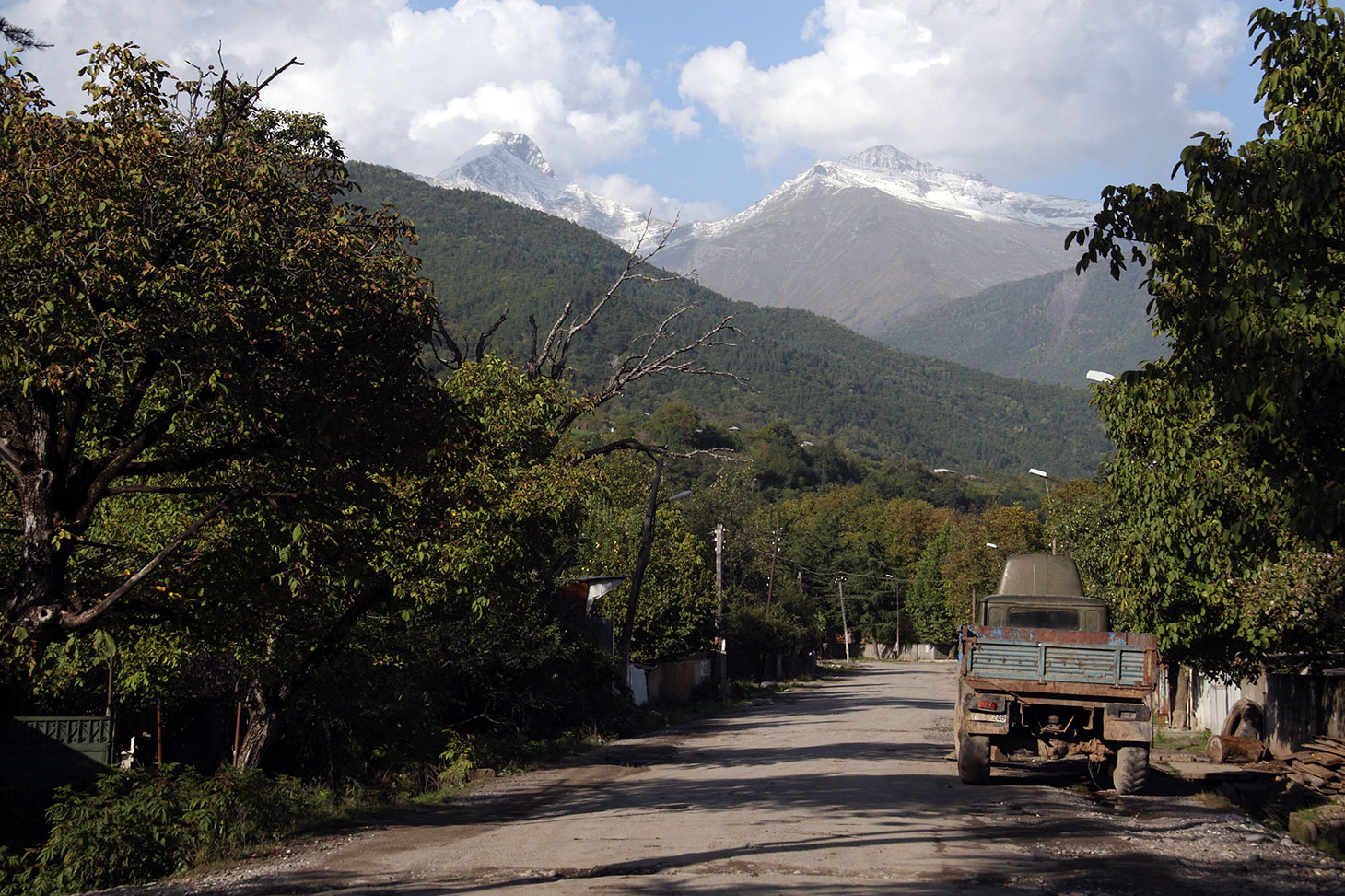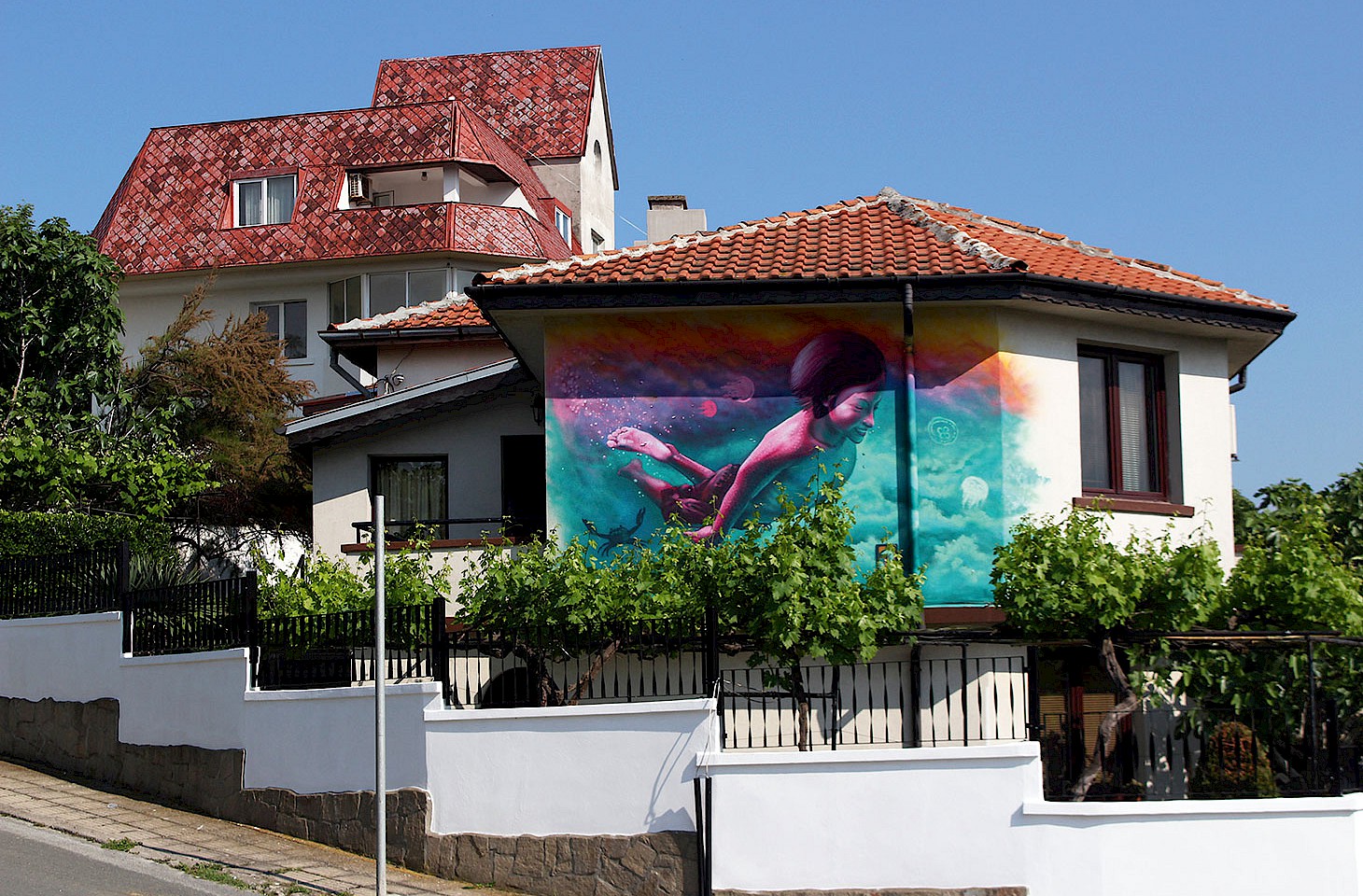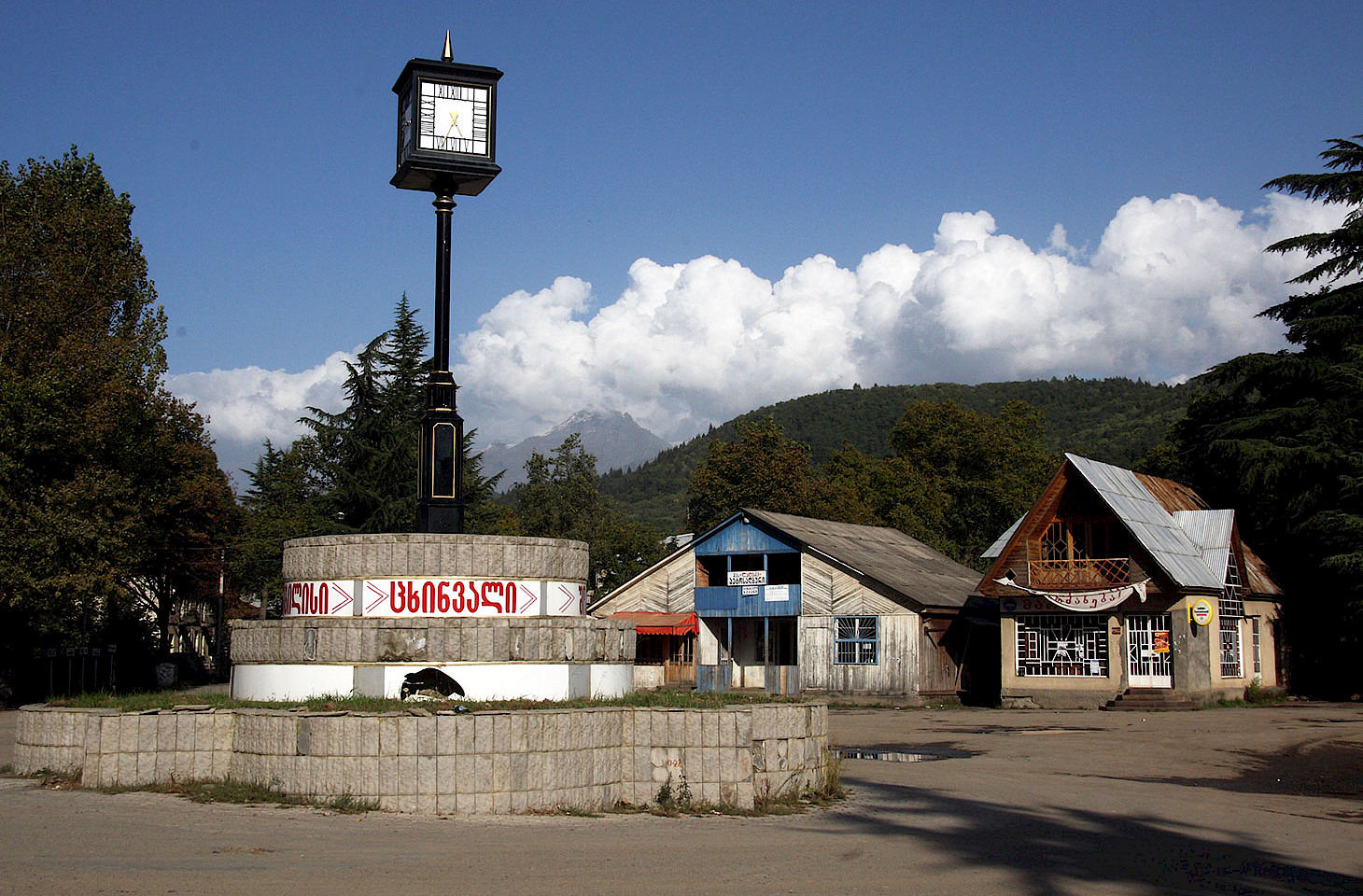It is early morning in Kutaisi, a city that lies astride the River Rioni in western Georgia. The country’s second largest city is a place that most people just pass through — a way station on the long drive along the M1 highway from Tbilisi to the coast.
In the middle of Kutaisi, down by the riverside, an assortment of battered old marshrutki (minibuses) are lining up, all rusting paintwork and wheezing engines — these vehicles have survived the worst of Georgia’s rutted roads, along the way clocking up mileages that surely equate to several circumnavigations of the world. Once they were smart, but now they live out their days kicking up dust on Georgian back roads.
Given the curious complexity of the curvaceous Georgian alphabet I am grateful that my destination is a simple three-letter word. I scan the signs on the vehicles looking for any evidence of ONI. It is always reassuring to have one’s destination confirmed in writing. After ten minutes striding up and down the line, I see it — ONI — or, rather, its counter-intuitive Georgian equivalent, on a destination plate propped in front of a steering wheel amidst a scattering of Georgian pop cassettes. (The Georgian language, ancient and mysterious as it is, is often counter-intuitive: where else does mama mean ‘father’, deda ‘mother’ and papa ‘grandfather’?)
I buy a ticket from a man seated at a trestle table and climb on board to grab a window seat. I am grateful to be seated at all, as even before leaving Kutaisi we are hugely overloaded with passengers standing in the aisle hanging on to whatever or whoever they can. The minibus is an 18-seater and I try to count the actual number on board but give up after reaching a tally of 31 plus driver. At least there is no need for safety belts as my travelling companions in the aisle brace me firmly in place — a taut bridge of compressed shoulders stretching window to window.
Oni lies several hours north of Kutaisi in Racha province, a beautiful mountainous tract of land that stretches from the lower lands of western Georgia up to the High Caucasus at the border with North Ossetia. Racha’s fluvial backbone is the Rioni River, which flows through Kutaisi and which we follow first north then east all the way upstream to Oni. Along the way, we make frequent diversions to clatter down dusty tracks to pick up from nameless (or, rather, sign-less) villages that lie away from the main road. There is clearly a dire shortage of public transport in the region and so this marshrutka provides a valuable service. No wonder then that it is so oversubscribed. Many of the passengers seem to make use of it for local travel between villages and, as far as I can tell, I am the only one aboard going all the way to Oni.
The town of Oni in Georgia close to the border with North and South Ossetia.
Racha province
Racha may be little known outside Georgia, but the province occupies a special place in the Georgian mind. It nudges up against the mountain ridges of the High Caucasus and thus boasts some fabulous scenery. It is widely seen as a province that maintains traditional Georgian values and customs — for the plains-dwellers, Racha is a province noted for its traditional religion, its honey and its inhabitants’ distinctive accents.
The Rach’veli are quick to remind visitors that their highland home was once an independent mediaeval duchy. For 700 years, the upper Rioni Valley and the surrounding mountains were the private fiefdom of a succession of eristavis — modern parlance might favour the translation warlords, but the Rach’veli themselves take a more benign view of their former rulers, and suggest that the word eristavi conjures up an image of a leader who presides with dignity over matters temporal and spiritual. Perhaps the phrase ‘father of the nation’ best captures the notion. Modern maps remind us that Racha is still one of Georgia’s edgelands: it borders onto both North Ossetia and South Ossetia.
Three hours into the journey, after countless passengers have got on and off, there is a sign for Chrebalo, which is unmarked on my map. Then it’s across a bridge to Ambrolauri, the largest town of Racha province. Then we backtrack to rejoin the main road on the north bank of the river. A little later, as we pass Barakoni Church at Tsesi, the women aboard all cross themselves as we speed by. The glimpse of the church is all too fleeting: a typically Georgian affair with a stubby skyrocket tower. It was evidently built by one of the last eristavis to preside over the affairs of Racha.
The marshrutka drops us off at a square that, however humble, is clearly the town centre — a huddle of plain wooden shops and an open area that has as its focus a rather self-important clock mounted above a purely decorative roundabout.
Finally, after four and a half hours of travel, we reach Oni, a small valley town on the Rioni River. Beyond the town the road splits, the northern fork climbing up steeply towards the main Caucasus Range. This is the Ossetian Military Highway, a great engineering adventure sponsored by the tsars in the mid-nineteenth century. It zigzags up from the Rioni Valley, just skirting the border with South Ossetia, then crossing into the Russian Federation at the summit of Mamison Pass. It is surely decades since any travellers ventured that way, but the road is open as far as the mountain resort hotel at Shovi just a few kilometres short of the border.
The other road beyond Oni is very much tamer. It follows the Rioni upstream to the South Ossetian town of Kvaisa (though nowadays more likely to be rendered in Cyrillic — Къуайса — as South Ossetia distances itself from all things Georgian). This too has become a no-go route, as the border with South Ossetia, just 15 kilometres upstream from Oni, is closed. Since the hostilities of 2008, Oni is effectively the end of the road. The town that once relied on traders from near and far passing through now finds itself bypassed by politics.
Arriving in Oni
The marshrutka drops us off at a square that, however humble, is clearly the town centre — a huddle of plain wooden shops and an open area that has as its focus a rather self-important clock mounted above a purely decorative roundabout. Even here, the mountains loom close: snow-capped peaks tower beyond the dark conifer-covered slopes of the Rioni Valley. I head off to find a room at the home of the Berishvili family, who despite the ‘guesthouse’ sign on the garden fence seem surprised to have someone wanting to stay. It comes as no surprise when I am told that few foreigners venture up to Oni, especially since the troubles of 2008. What is perhaps a surprise though is to hear that what few strangers do come this far are mostly from Israel. Oni was a little outpost of Judaism in the mountains of Georgia, and once had a sizeable Jewish community. Most of them emigrated in the 1970s. In that decade alone, over 300 families from Oni and surrounding villages made aliyah to Israel.

A quiet, leafy street in Oni. the peaks of the High Caucasus rise beyond the town (photo © Laurence Mitchell).
Jews are said to have lived in Georgia for around two and a half millennia, perhaps since after the siege of Jerusalem and the destruction of First Temple by Nebuchadnezzar II in 587BC. Whatever the precise date of their arrival in Georgia, there has been a Jewish presence in Oni since at least the 15th century, and before their mass exodus in the 1970s, Jews were said to make up one third of the town’s population. Despite the anti-religious purges of the Bolsheviks and the blatant anti-Semitism of home-grown tyrant Stalin, Georgia’s Jews fared better than those in many other countries, and when Communists threatened to destroy Oni’s synagogue in 1917, locals of all faiths stood firmly to defend it with the result that it was spared. The synagogue still stands today, an impressive square, neoclassical building with a silver-coloured dome.
A visit to the synagogue
The synagogue, the third largest in Georgia, lies just north of the centre close to the town’s only petrol station. As I hover expectantly in front of the barley-twist stone columns of the building’s main door, a short elderly man carrying a bunch of keys emerges from the blue house opposite to unlock and let me inside. The interior is crowded with benches that face across to each other as if in a debating chamber. Painted in an archway in the centre of the temple is a strange child-like mural in orange and purple that looks like a Gauguinesque South Sea island but more probably represents the parting of the Red Sea during the Exodus. On the pillars flanking the Bema, the raised table from which the Torah is read, are painted menorot — the ritual candelabras of Judaism. There are minor cracks in the pink plaster of the ceiling and the atmosphere is redolent of dust and old paper yet there is little sense of abandonment. This is no museum but a working temple, albeit one with a largely depleted congregation. It is clear that prayer and study still take place here — tables are cluttered with leatherbound tomes in Russian, Georgian and Hebrew, and neat heaps of torn books and ripped-out pages are piled high in window niches — in Judaism, religious texts, however badly damaged, cannot be simply discarded but must be disposed of ritually.
The synagogue was renovated in 1995 for the centenary of its foundation, rectifying the damage caused by a powerful earthquake that had struck the town a few years earlier in 1991, a devastating seismic upheaval of magnitude 7.0 that was the most powerful ever recorded in the Caucasus. Many of Oni’s Jewish population had already left for Israel by the time of the earthquake but the event prompted even more to emigrate. Estimates vary about the number of Jews that remain in the town today: some say 20 families, others say a total congregation of 30 — either way, it is now but a tiny fraction of what it used to be.
Close to the synagogue on Baazoba Street stands a cemetery that not only has Jewish graves but Orthodox and Soviet-period ones too, with crucifixes, Stars of David and communist red stars mingling freely in the long grass. The streets are quiet, with few abroad other than occasional pairs of black-garbed women strolling in conversation. In Georgia, black is the colour of choice for both men and women, young and old — it has nothing to do with mourning. Although its natural surroundings are magnificent, the town itself has few aesthetic frills, just a few hoardings for mobile phones and hand-painted signs of cartoon teeth-filled mouths advertising dentists. Here and there, torn posters remain from the last election campaign depicting President Saakashvili in ‘people’s champion’ mode greeting workers on the street. North of the square stands a small church with a walled garden that has a curiously large statue of Daniel and the Lion; the church’s bell tower is less impressive — an economy version with just an open wooden platform to suspend the bells.
Land of the Golden Fleece
A single bridge leads across the Rioni River, a wide, shallow stream that sparkles in the late afternoon sun and looks perfect for trout. On the other side, a track climbs steeply through trees to reach a pristine white chapel on top of a hill. In late summer there are plenty of reminders that this is a legendary land of plenty, the fabled land of the Golden Fleece — apples are ripening on trees and pomegranates cracking open on bushes to reveal sweet pulpy treasure; grapes are ready for harvesting, walnuts have already been gathered. The chapel, prosaic by Georgian standards, offers little of interest but the climb is worth it for the view alone: Oni’s lowrise roofline is partly hidden by trees but beyond the town purple mountains rise dramatically and abruptly in the direction of Ossetia — a lush landscape, the sort that might give birth to an ancient nation with rich traditions of food, song and culture.
This bounteous world view is confirmed at my guesthouse that same night, where in my honour a supra takes place. Supra translates literally as ‘table cloth’ but what it really means is a Georgian-style feast, with food, wine and toasts. The whole family is present, and the food is plentiful, wholesome and honest — hearty stews, vegetables and fruit from the garden, home-made jam and preserves and home-produced wine. It is an unhurried affair that takes up most of the evening, each of us picking at the food in no particular order with periodic breaks for toasts and short heartfelt speeches by all present. As the evening concludes, it is decided I will return to Oni again one day soon, and then I will make a speech in Georgian — simple as that. I know deep down that this is very improbable, but the sincerity and warmth that accompanies the invitation strikes just the right note.




